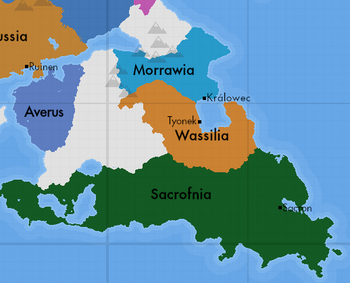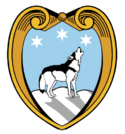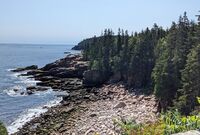Wassilia
Federal Republic of Wassilia Federacinė Respublika Wassilia | |
|---|---|
 Wassilia Location in Southeastern Thrismari | |
| Capital | Tyonek |
| Largest city | Bursinai |
| Official languages | Wassilian |
| Ethnic groups | 86% Wassilian Sub-groups of Wassilian Austaran 33% Isteraian 30% Vyssan 23% Olavaian 14% 8% Morrawian 3% Sacrof 2% Other Thrismari 1% Other International |
| Demonym(s) | Wassilian |
| Government | Federal Republic |
• President of Wassilia | Ausra Kelavarne |
• Vice President | Octanius Milliokas |
| Legislature | The Treimas |
| The Delegation | |
| The Commune | |
| Area | |
• Total | 589,306 km2 (227,532 sq mi) |
| Population | |
• 2020 estimate | 41,798,810 |
• Density | 70.9/km2 (183.6/sq mi) |
| GDP (nominal) | 2019 estimate |
• Total | $83.172 billion |
• Per capita | $25,646 |
| HDI (2019) | 0.805 very high |
| Currency | Wassilian Ohre |
| Time zone | UTC-0, UTC+1 |
| Date format | yyyy.mm.dd |
| Driving side | right |
| Calling code | +485 |
| Internet TLD | .wa |
The Federal Republic of Wassilia, FR Wassilia or just Wassilia, is located in the southeastern portion of Thrismari, a continent of Anteria along the Sunadic Ocean.
National Overview
The Federal Republic of Wassilia lies on the southeastern peninsula of Thrismari and has two major land borders with other soverign nations. In the north Wassilia has a long border with the nation of Morrawia. To the south Wassilia has very long border with Sacrofnia. To the east are the water bodies of the Sunadic Ocean and the Wallach Sea. The southern border with Sacrofnia is dominated by the Selianakis National Forest. A dense canopy coniferous forest of rolling hills with very few settlements and during winter this is also where the coldest temperatures in Wassilia can be found. The capital city of Wassilia is Tyonek, on the inner western shore of the Wallach Sea. The largest city however is Bursinai, a bustling metropolitan city on the Sunadic coast. The other major cities in Wassilia include Garibaldas and Altapadus in eastern Wassilia, Sren and Utapadys in the central portion and Olesenai, the largest western Wassilia city. The government of Wassilia is a democratically elected body with a legislative government known as the Treimas. Wassilia is divided into 18 provinces with each having its own capital for administrative purposes.
History
Wassilian Origins
The first Wassilians to settle the modern day borders of the state were located along the Austaras River at Sren. This was due to the Sren area being highly fertile for farming as it still is today. As the size of the city grew more settlers expanded into the Olesenai area up river and Tyonek down river. Tyonek quickly became the most important city as the port city became a central hub of trade in southeastern Thrismari. The population soon expanded rapidly around the Wallach Sea with the cities of Garibaldas, Altapadus and Bursinai as well as the Errala peninsula, seeing the quickest growth in Wassilia.
These largest cities in Wassilia became very influential over their surrounding areas and the families in charge of the cities setup a network of city-states which would control their respective territories and the landowners of the rural outlying regions would ally themselves with the city-states to broker a mutually beneficial relationship. Cities like Bursinai, Altapadys, Garabaldas and Eleksiadorys generally held all of the power in the east and sunadic coast region, while Sren, Tyonek, Utapadus and Olesenai would control the western half of Wassilian territory.
Wassilian Confederation (1412-1755)
By the beginning of the 1400s Wassilia was a loose federation of many city-states known as the Wassilian Confederation These city-states all had loose alliances for protection of local areas. Large city states like Sren, Altapads, Tyonek and Bursinai often influenced the smaller ones and used them as needed for advantages. The government however was not a strong central force with a single military. Each country of the Confederation maintained it's own standing Army and Navy which hampered it's coordination.
First Morrawo-Wassilian War (1645-1650)
It was in September of 1645 when the Empire of Morrawia would begin it's invasion of Wassilia and started the First Morrawo-Wassilian War. Wassilia's de-cetralized armies were unprepared for this and it showed as Morrawia moved 150,000 troops south in a three-pronged assault claiming the northern half of the Errala Peninsula, northern Austaras, and much of Northwest Wassilia. After the first 6 months Morrawia had claimed victories at Laurdru, Altapadys and Kinsalas capturing the larger northern cities in decisive victories. As Morrawia's armies continued to push south in the western theater, Confederation leaders made the decision to move the capital from Tyonek to the city of Constantius which is further south on the Eser River. Wassilia needed to have a functioning government if it would be able to withstand further invasion.
As Morrawia approached Tyonek the war began to stabilize and Confederation armies began to slow down it's progress. In the east, the Wassilian Ister armies held out in southern Errala, winning the Battle of Solvenus and preventing an eventual siege of Wassilia's second largest and now most important city of Bursinai on the Sunadic Coast. In the west however, Morrawia made steady progress through the mainly flat farming plains of northwest Wassilia and taking the city of Olesenai.
In spring of 1650 Morrawia was able to finalize control of the former capital of Wassilia, Tyonek. This was a highly costly victory for Morrawia, and it was believed that it would not be able to push much further south into the more challenging terrain so far away from the homeland. This combined with Wassilian victories in the east stopping the Morrawian advance down the Errala Peninsula led to national leaders from both parties to broker the 1650 Treaty of Sren. This treaty legitimized the Morrawian gains and the creation of buffer vassal states of Posári, Awárie and Erolsko. These states were majority a Wassilian population with leaders loyal to the Empire of Morrawia.
A result of the Treaty of Sren was a significant portion of the Wassilian population of the northern territory annexed and the Vassal states immigrated either to eastern Wassilia or to the Oliviacian continent specifically to the United Kingdom of Mygona. This would transpire over the course of the next several generations. Before the war started about 67% of the Wassilian population, after the Treaty of Sren eastern Wassilia would have a population majority of 53%. A difference that would never reverse.
Dark Period (1650-1755)
The timeframe from the end of the First Morrawo-Wassilian War in 1650 until the formation od the Federal Republic of Wassilia in 1755 is called by most the Dark Period. After the war, the massive loss of territory led to a national decline in prosperity as not only did the nation lose many of its citizens as casualties of combat and city sieges, many Wassilians fled the occupied territories leading to a large population decline. It would take about 50 years for the nation to recover it's agricultural output to the point of sustainability as the living standards had declined dramatically. This would plant the seeds of nationalism as the people of Wassilia saw national unity would be the only way to bring all of its people together again.
Federal Republic of Wassilia (May 7th 1755)
On the 7th of May, 1755 the delegation of the Wassilian Confederation had decided to dissolve the old Confederation government and form a new centralized government voted on by the citizens. This new Federal government would have authority over all provinces in matters of national security and defence as well as larger economic issues.
Demographics
Wassilia has an estimated 41.7 million inhabitants with the large majority being native Wassilians. Although Tyonek is the capital city and the cultural and historical hub of Wassilia, since the 2010 national census Bursinai has surpassed in population. Bursinai in the 20th century has become Wassilia's most important trade and tourist hub sitting on the Sunadic coast.
Largest Cities in Wassilia
Wassilian 2020 Census | |||||||||
|---|---|---|---|---|---|---|---|---|---|
| Rank | Region | Pop. | |||||||
 Bursinai  Tyonek |
1 | Bursinai | Ister | 2,230,210 |  Sren  Garibaldas | ||||
| 2 | Tyonek | Austaras | 2,175,560 | ||||||
| 3 | Sren | Iraltai | 1,519,800 | ||||||
| 4 | Garibaldas | Delsin | 1,494,250 | ||||||
| 5 | Altapadus | Errala | 765,120 | ||||||
| 6 | Olesenai | Olavai | 502,960 | ||||||
| 7 | Constantius | Galo | 472,820 | ||||||
| 8 | Eleksiadorys | Vyssas | 435,780 | ||||||
| 9 | Utapadus | Aventius | 406,780 | ||||||
| 10 | Laurdru | Austaras | 295,630 | ||||||
Ethnicities of Wassilia
In Wassilia, all native people are considered Wassilian to the international community. Domestically however, there are 4 different subgroups of Wassilian people which are largely identifiable through dialect differences of the Wassilian language and historical rivalries. The largest of those groups are the Austarans, whose culture is centered around the capital city of Tyonek, as well as Sren, Utapadys and Laurdru. Austarans are historically the more populous as well as being more likely to be in a leadership role as they originally set the unification of Wassilia in motion in the 1700 and 1800s. Along the eastern coastline and Errala peninsula is the Isteraian subgroup. Major cities of the Isteraian group would include Bursinai and Altapadus. This group is has traditionally been known for being more relaxed in nature and less focused on unification in general, as the groups was the more disconnected from the rest of Wassilia when it came to Wassilia as a whole. As a result, the Isteraian dialect is the most pronounced of all four groups, however all Wassilian dialects can be understood across the country including Isteraian Wassilian. Geographically located between Austarans and Isteraians is the Vyssan subgroup centered around the cities of Garibaldas and Constinatius. This is the group that is known historically for using sled dog teams in the winter months though the southern rough terrain of the Selianakis forests. On the farthest north and west of Wassilia is the Olavaian subgroup. The people located around the city of Olesenai most notably known for their strong agricultural background and unique dialect.
Religion
By definition of the constitution, Wassilia is a secular nation specifying that there is no national religion. However, Hithos is the dominant Religion practiced by Wassilians accounting for approximately 63% of the population. By and large though religion in Wassilia is declining as the fastest growing demographic in religion is agnosticism. Hithos is a polytheistic religion practiced largely in Wassilia where worshippers pray to the many gods and goddesses which represent the earth and it's elements.
Physical Geography
Geography
The total land area of Wassilia is 589,306 km2 and this area lies between the latitudes -43 deg and -52 deg, N and longitudes of 1 deg and 16 degrees E. Wassilia does not have any overseas territories, so the entirety of land area is contiguous. The largest city Bursinai lies on the east coast of Wassilia with the capital city, Tyonek on the west shore of the Wallach Sea. The Wallach Sea dominates the eastern lowlands of Wassilia which is mostly low hills and large river plains very fertile for farming purposes. The Errala peninsula, which juts out to the north forming the eastern edge of the Wallach Sea.
On the southeastern shore lies the picturesque port city of Riva, and the Ginellus National seashore made of large bedrock shores and heavy pine forests. The Dynerri National forest in the far northwest corner of Wassilia is where you will find the largest mountains in Wassilia with the tallest peak, Mt. Roulei at 3,240 ft. The mountains can often be seen snow covered in the winter, but all snow will melt by mid spring.
Waterways within Wassilia generally run to the north or the east depending on their source. Nearly all rivers from the southern hills flow north and empty into the Wallach Sea or to the northeast and flow into the Sunardic Ocean. The Belken River flowing from the western edge of the soutthern hills to the Wallach Sea is the traditional east/west divide of the nation. Rivers in the west flow generally to the east eventually to the Wallach Sea. The Ellersai River is the most famous in Wassilia connecting the major cities of Olesenai and Sren with the capital of Tyonek.
The coastal eastern half of Wassilia is known for its beautiful waterfront cities, small towns, and rocky shoreline. Much of the eastern coastline is made of rocky shore dotted with many lighthouses and fishing towns. The coast becomes more mountainous as you head south toward the city of Ister. Around the Wallach Sea is the coastal lowlands which is the most densely populated area of Wassilia. In the southern most province of Wynsoia we have the Southern hill and valley region which dominates the landscape here.
In the far northwest of the country of Wassilia is the Dynerri National Forest and the only place where you will find a significant mountain range. The ____ mountains continue on to the north along the western border of Morrawia and south past the Wassilian city of Kybarstona to western Iraltai Province and Provost Province.
Climate
Wassilia has a humid continental climate (Köppen climate classification Dfb), with warm (although mostly not hot), humid summers. Winters are cold and snowy all over the country and are more severe in the southern region. The coastal lowland areas and seaside are more temperate in the winter due to the warmer currents of the Sunardic Ocean and Wallach Sea. Wassilia is mostly safe from tropical cyclones as the higher latitude weakens these systems to extratropical by the time they reach the Wassilian shoreline.
Government
Federal Assembly (Treimas)
The legislative body of Wassilia is the Treimas which is located in the downtown area of the nations capital city of Tyonek. The Assembly consists of two distinct houses of legislature. The upper house, also known as The Delegation, has 108 members while the lower house, or The Commune is composed of 215 members which are elected via representative voting throughout the 18 provinces of Wassilia. Larger provinces will have larger representation as compared to smaller ones. Each province is divided into voting districts to allocate that provinces' delegation to the Treimas. Each assembly member is elected to a 4 year term with a limit of 3 terms. Terms can be consecutive or not either way only 3 terms are possible.
President
The House of the First Estate, is the official head of state of the Federal Republic of Wassilia as well as chief executive of the government and military. The position is also known as The President of Wassilia when referring only to the chief executive. The First Estate refers to all of the Governor's official Counselors and staff working as part of the Executive Cabinet.
Presidential History Brief
The position of House of the first Estate was created by a combination of both legislative houses when in 1556 the former king, King Adomas VII was deposed after Royalist forces were defeated in the final battle of the Wassilian Republican-Royalist War at Coloris. It was decided then that monarchist rule was to come to an end and a democratic leader would run the nation from then on. The 2 houses would choose among The Treimas who was to run for the first office of President and then the citizens would vote the winner. That first election saw 4 parties nominate candidates 2 of which were from the Republican parties and 2 from the Royalist conservative parties. In a landslide vote both Republicans advanced to a run with neither receiving the 50% total in order to win outright. The two candidates competed in a second round and Hectaris Zikoras would win of the Ulatinis Party defeating Elmantas Graute of the Delmas Party 53%-47%.
Modern day First Estate
Today the process of electing the President is similar to that first election. Each party that wishes to nominate a candidate chooses from the population at large which is a party member. Then the House of the The Delegation must vote for whether or not to allow the candidate to continue. This vote is primarily a yes or no check on whether the candidate is qualified and the vast majority of candidates pass the vote. Then the candidates campaign and the first round of voting takes place on the first Saturday of September. If no candidate receives 50.1% majority the highest two vote earners will have a run off election on the first Saturday in November for the final deciding vote. When elected, the Governor forms his/her Executive Cabinet and resides at the President's mansion in Tyonek for a 5 year term.
The current President of Wassilia is Ausra Kelavarne of the Center-Left Chorrus Party in 2021. She defeated Clarius Jokanauskas by a commanding 54%-46% vote becoming the third female President of Wassilia. Kelavarne is a criminal justice lawyer in her home city of Utapadus and ran on a unique platform of criminal justice and social inequality gathering a broad coalition to vote. Her opponent, Jokanauskas, was of the traditionally conservative Alkranas Party surprisingly beating out the moderate right Trente party candidate in the first round.
Political Parties
Chorrus Party - Center-Left Moderate Progressive
Trente Party - Center-Right Libertarian Conservative
Alkranas Party - Right-wing Conservative
Progranas Party - Left-Wing Progressive
Foreign Relations
Wassilia is a member of the South Sunadic based Vedoti Pact since joining in February of 2023. The pact is both a defensive alliance as well as economic alignment strengthening ties among neighboring South Sunadic peoples. It's closest relations are with other southeastern Thrismari nations like Morrawia, Barceria, Kakland, who are also Vedoti Pact members as well as Mygona, in southwestern Oliviacia. Mygona has the largest diaspora of Wassilian population outside of the home country.
Culture
Sport
Sports in Wassilia are very popular in both the spectating aspect as well as participation. It is very common for youths to compete in multiple sports up into the teenage years before settling on one. Association football, ice hockey, tennis, cycling, as well as the Olympic sports are the most popular youth participation sports.
Spectating for sports is also very popular among Wassilians. Association football is among the highest attended sports leagues. The Pirmas Lyga is the top level of association football in Wassilia and is immensely popular among the population. Some of the biggest clubs are Olimpinis Bursinai, Linnaeus Bursinai, Klubas Tyonek and SK Sren.
Motorsports are also very popular in Wassilia especially Rally racing, or just Rallying. RALLY Racing is a form of motorsport where cars race against the clock on numerous stages across roads of tarmac, gravel, ice and snow. The Wassilian Rally Series (WNRS) brings out thousands along roadsides across getting very close to the action. Due to the lower costs involved with Rallying compared to most circuit racing events, it quickly became the more popular form of Motorsports in Wassilia.
The Wassilian CCG EliCar Series is also popular especially the Elienople 500 mile race. This race is the highest attended single day sporting event in all of Wassilia. The EliCar Series is a formula car single seater racing series that competes in races all around Wassilia and a few neighboring countries. The series is unique in that it competes on permanent road courses, street circuits in large cities as well as oval tracks.
National animal
In Wassilia, there is no question that the canine is the favored companion animal, and among them, the Wynsoian Husky is the most well known and beloved. The breed, which is a working dog, was used to aide human work in the rough countrydide of southern Wassilia. The dog loves to have something to do and excels in the cold winters of the south. The famous sled dog teams were used in southern and western Wassilia to travel the thick snow covered forests before vehicles became commonplace. The average size of a Wynsoian Husky is between 45 and 60 lbs, heavier for males lighter for females.
Economy
The Central Bank of Wassil in Tyonek serves as the central bank for the country. The Wassilian currency is the Wassilian ohre (Wor). The Wassilian economy has grown substantially in the 20th and 21st centuries due to a stable government and policies that encourage private investment as well as now seeing more foreign investment in Wassilia's mining and agricultural sectors from the strongest economies of Thrismari.
Agriculture
The largest sectors of the Wassilian economy are in fishing/seafood, agriculture, service, mining, manufacturing and tourism. It is primarily known as an exporter of a multitude of grains including wheat, barley, oats, alfalfa, corn and soy. All farms in Wassilia are privately owned and the majority of the farming industry can be found in the northwest of the country.
Fishing and Vineyards
In the east, you will find two of Wassilia's other prime exports, those being wine and fish. The Wallach Sea and Sunadic Ocean provide many species of fish including Sunadic char, cod, halibut, tuna and sea bass. In addition to soft fish many shellfish are caught including Ister crab, lobster, mussels and clams. Ister crab is what the Sunadic coast is most known for and is a delicacy in the major city of Bursinai.
Automotive and Transportation
The auto industry in Wassilia is not quite as robust as some of the other Thrismari neighbors however the country is served by three major automobile manufacturer's which assemble all cars in Wassilia. There is Vektras Automobilai headquartered in the suburbs of Tyonek, Preiniste Motos based in Sren, and Belkentrek which is based in Garibaldas. All three have multiple assembly plants within Wassilia and abroad. The federal government is in charge of maintaining the national highway system which was designed in the 1960s was largely built from the 1970s through the 1980s. Multiple projects are ongoing still in the more rural west and of course with population growth the constant need for improvements and widening.
Wassilia has a robust railway network comprising both light commercial and passenger rail as well as freight rail.
The nation of Wasillia is served by two main nationwide airlines which have many domestic and international flights. Those two airlines being Wass Air headquartered in Tyonek and Argosai Air headquartered in Bursinai. Wassilia's location on the eastern Sunadic coast means it is often a layover stop for travelers crossing the continents of Thrismari and Oliviacia especially. The Tyonek and Bursinai airports are among the busiest in eastern Thrismari for this reason alone.











